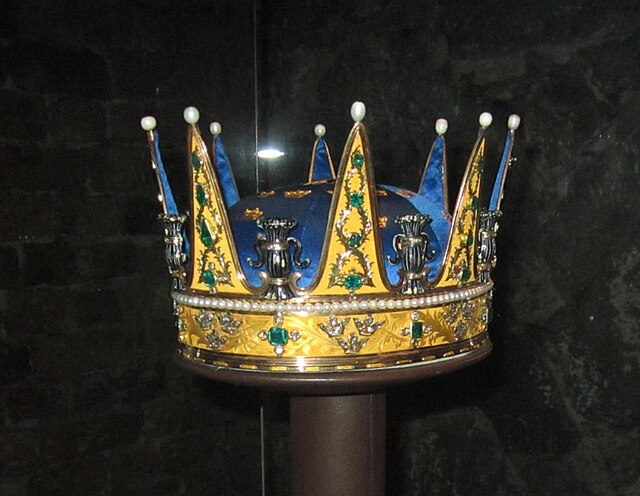In British heraldry, a coronet is any crown whose bearer is less than sovereign or royal in rank, irrespective of the crown's appearance. In other languages, this distinction is not made, and usually the same word for crown is used irrespective of rank In this use, the English coronet is a purely technical term for all heraldic images of crowns not used by a sovereign, and implies nothing about the actual shape of the crown depicted. A Coronet is another type of crown, but is reserved for the lower ranks of nobility like Marquesses and Marchionesses, Earls and Countesses, Barons and Baronesses, and some Lords and Ladies. The specific design and attributes of the crown or coronet signifies the hierarchy and ranking of its owner.
Coronet of an earl (as worn by the 17th Earl of Devon at the coronation of Elizabeth II and now on display at Powderham Castle).
Depiction of a baron's coronet on a 17th-century funerary monument
The coronet of a Swedish duke (always a Swedish prince).
A crown is a traditional form of head adornment, or hat, worn by monarchs as a symbol of their power and dignity. A crown is often, by extension, a symbol of the monarch's government or items endorsed by it. The word itself is used, particularly in Commonwealth countries, as an abstract name for the monarchy itself, as distinct from the individual who inhabits it. A specific type of crown is employed in heraldry under strict rules. Indeed, some monarchies never had a physical crown, just a heraldic representation, as in the constitutional kingdom of Belgium.
Imperial Crown of Kingdom of Sicily (Crown of Constance of Aragon, Cathedral of Palermo).
Imperial Crown (Benkan) of Emperor Kōmei of Japan
Imperial Crown of Austria
Imperial Crown of Russia, 2012 replica







